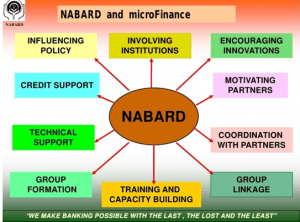FULL FORM OF NABARD-ROLE & FUNCTION
INTRODUCTION
- National Bank for Agriculture and Rural Development (NABARD) is an Apex Development bank for agriculture and rural Development in India.
- It was established on the recommendations of B. Sivaramman Committee on 12 July 1982 to implement the National Bank for Agriculture and Rural Development Act 1981.
- The first chairman was shri B. Sivaraman (former member of Planning Commission, Government of India).
- NABARD replaced the Agricultural Credit Department (ACD) and Rural Planning and Credit Cell (RPCC) of RBI (Reserve Bank of India) and Agricultural Refinance and Development Corporation (ARDC).
- It is one of the premier agencies providing developmental credit in rural areas. However initial corpus of NABARD was Rs.100 crore only. Consequent to the revision in the composition of share capital between Government of India and RBI, NABARD today is fully owned by Government of India. Its’ paid up capital stood at Rs.12, 580 crore as on 31 March 2019.
Role of NABARD
It aimed at building an empowered and financially inclusive rural India through specific goal oriented departments which can be categorized broadly into three heads:
- Financial,
- Developmental and
- Supervision.
The SHG Bank Linkage Project launched by NABARD in 1992 has blossomed into the world’s largest microfinance project. Kisan Credit Card, designed by it has become source of comfort for crores of farmers in India. The overall roles are as follows:

- It serves as an apex financing body for facilitating credit flow for promotion and development of agriculture, cottage and village industries.
- Takes measures towards institution building for improving absorptive capacity of the credit delivery system, including monitoring, formulation of rehabilitation schemes, restructuring of credit institutions, training of personnel, etc.
- It also co-ordinates the rural financing activities of all institutions engaged in developmental work at the field level and maintains liaison with Government of India, state governments, Reserve Bank of India (RBI) and other national level institutions concerned with policy formulation.
- It monitors and evaluates the projects refinanced by it.
- NABARD refinances the financial institutions which finances the rural sector. (NABARD receives refinance fund assistance from World Bank & Asian Development Bank).
- NABARD coordinates the institutions which help the rural economy.
- It acts as regulator of the institutions which provide financial support to the rural economy.
- It also provides training programs to the institutions working in the field of rural development.
- NABARD supervises State Cooperative Banks, District Cooperative Central Banks (DCCBs), and Regional Rural Banks (RRBs) and conducts statutory inspections of these banks.
Read more..
KISAN CREDIT CARD- OBJECTIVES & REVISED FEATURES
AGRICULTURE IN INDIA: Development & Present Scenario
TYPES OF FARMERS-GOVERNMENT INITIATIVES
KRISHI VIGYAN KENDRA
INTEGRATED FARMING SYSTEM
TYPES OF FARMING- SYSTEM OF FARMING
WHAT IS ORGANIC FARMING
SUBSISTENCE FARMING-HISTORY & TYPES